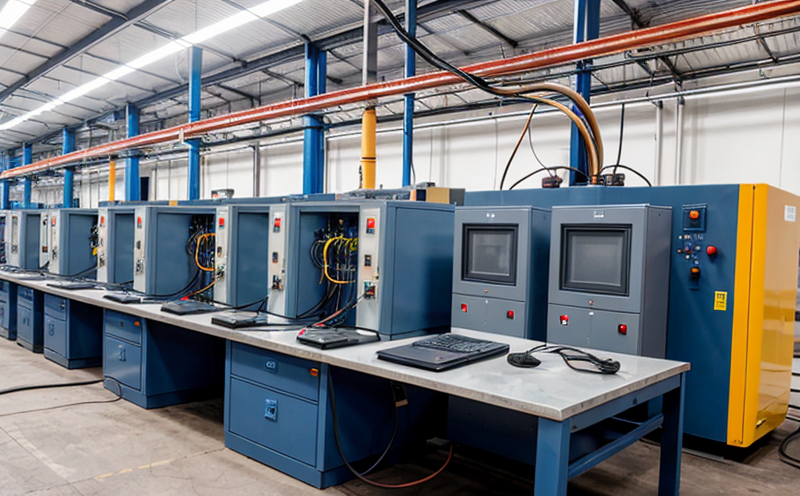IEC 62061 Functional Safety Testing of Control Systems
The IEC 62061 standard is a critical component in ensuring the functional safety of control systems, especially in sectors where high reliability and safety are paramount. This standard addresses the challenges inherent in designing and testing complex electrical and electronic components that form part of larger industrial machinery and processes.
Functional safety focuses on preventing accidents caused by faults in safety-related control systems. IEC 62061 provides a structured approach to achieve this, which includes:
- Identification of the functional requirements for safety
- Detailed design considerations
- Risk assessment and analysis
- Testing methodologies
- Operational monitoring and maintenance
- Continuous improvement through audits and reviews
The standard covers a wide range of control systems, from simple relay-based to complex microcontroller-driven systems. Its application is crucial in industries such as automotive, aerospace, chemical processing, pharmaceuticals, and manufacturing.
The testing process under IEC 62061 ensures that the system complies with safety integrity level (SIL) requirements, which are critical for preventing accidents due to malfunctions or failures. The standard specifies various tests, including:
- Component-level testing
- System integration testing
- Presentation of failure modes and effects analysis (FMEA)
- Demonstration of software algorithms
- Validation of hardware interfaces
- Evaluation of system interactions under fault conditions
The process involves multiple iterations, ensuring that the control systems are robust against all potential failures. This approach not only enhances safety but also minimizes downtime and operational risks.
| Test Type | Description |
|---|---|
| Component-level testing | Detailed examination of individual components to ensure they meet the specified functional requirements. |
| System integration testing | Evaluation of how individual components interact within the system as a whole. |
| Presentation of FMEA | Analyzing potential failures and their effects on the control system to identify mitigation strategies. |
| Demonstration of software algorithms | Verification that the software performs its intended functions under all specified conditions. |
| Evaluation of hardware interfaces | Checking the compatibility and reliability of hardware components in the control system. |
| Evaluation of system interactions under fault conditions | Testing how the control system responds to faults, ensuring it operates safely in all scenarios. |
The testing process is rigorous and involves multiple stages. Each stage builds on the previous one, ensuring that any potential issues are identified early in the development cycle. This approach not only enhances safety but also ensures that the control system meets international standards such as IEC 62061.
In summary, IEC 62061 Functional Safety Testing of Control Systems is a vital process for ensuring that complex industrial machinery and processes operate safely and reliably. By following this structured approach, organizations can mitigate risks associated with functional failures, thereby protecting both personnel and assets.
Quality and Reliability Assurance
The quality and reliability assurance process under IEC 62061 is designed to ensure that control systems meet the highest standards of safety and performance. This involves a comprehensive approach to testing, validation, and certification.
- Comprehensive Testing: The standard mandates thorough testing at various levels, from component-level to system integration.
- Rigorous Validation: Each test is validated against the specified functional requirements, ensuring that all components perform as expected under all conditions.
- Certification: Upon successful completion of all tests, a certificate is issued, confirming compliance with IEC 62061.
The process also includes continuous monitoring and maintenance to ensure long-term reliability. Regular audits and reviews are conducted to identify any potential issues and implement corrective actions promptly.
The commitment to quality and reliability is further enhanced through adherence to international standards such as IEC 62061, which provides a framework for consistent and repeatable testing methods.
Competitive Advantage and Market Impact
Adhering to the stringent requirements of IEC 62061 offers significant competitive advantages in the market. Organizations that comply with this standard:
- Elevate Brand Reputation: Compliance with international standards enhances trust and credibility among customers.
- Increase Market Share: By ensuring safety, reliability, and performance, organizations can attract more business from industries with stringent safety requirements.
- Promote Innovation: The structured approach to testing encourages the development of safer and more efficient systems.
- Reduce Downtime: Robust testing minimizes the risk of system failures, leading to reduced downtime and operational costs.
The market impact is profound as industries rely on high-quality control systems for critical operations. Compliance with IEC 62061 ensures that these systems are dependable, contributing to overall industrial safety and efficiency.
In addition to these benefits, organizations can also leverage the standard's international recognition to expand into global markets, particularly in sectors where functional safety is a regulatory requirement.
Use Cases and Application Examples
The IEC 62061 Functional Safety Testing of Control Systems is applicable across various industries. Here are some key use cases:
- Aerospace: Ensuring the safety of avionics systems that control critical flight functions.
- Automotive: Enhancing safety in vehicle control systems, including braking and steering mechanisms.
- Chemical Processing: Protecting personnel and assets in hazardous environments by ensuring safe operation of chemical processing plants.
- Pharmaceuticals: Guaranteeing the accuracy and reliability of automated drug dispensing systems.
The following table provides more specific use cases and application examples:
| Industry Sector | Control System Application |
|---|---|
| Aerospace | Avionics systems for flight control, navigation, and communication. |
| Automotive | Braking systems, steering mechanisms, and engine management systems. |
| Chemical Processing | Hazardous chemical processing plants with automated safety interlocks. |
| Pharmaceuticals | Automated drug dispensing systems in healthcare facilities. |
The standard's flexibility allows for its application across various industries, making it a versatile tool for ensuring functional safety in complex control systems.





